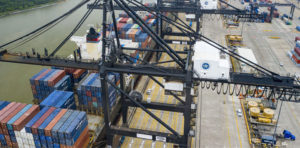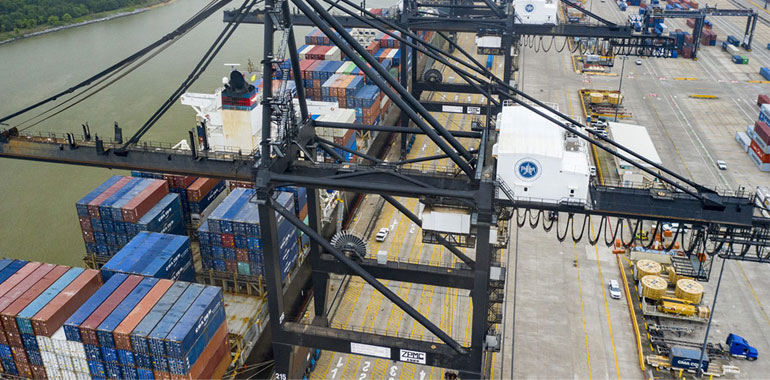
After a decade-long campaign by maritime industry stakeholders, Congress has authorized the expansion of the Houston Ship Channel for safer and more efficient navigation. The project will widen and deepen the nation’s busiest waterway, which is accommodating increased traffic and ever-larger ships.
The green light came on Dec. 27 with enactment of the Water Resources and Development Act of 2020 (WRDA), followed three weeks later by a “new start” designation from the U.S. Army Corps of Engineers that provided $19.5 million to begin construction. A collaboration between private companies and public entities was crucial in advancing the planning and design of the project.
The initiative, known as Project 11, will widen the channel along its Galveston Bay reach from 530 to 700 feet and will deepen upstream segments up to 46.5 feet, according to Roger Guenther, executive director of Port Houston. The estimated cost of the project is between $877 million and $1 billion.
The channel is about 40 feet deep and 300 to 400 feet wide for most of its 52-mile length. With the expansion, Port Houston will be able to handle neo-Panamax containerships that carry up to 15,000 TEU, Guenther said.
The channel is lined by about 200 private terminals and eight public terminals. The public terminals are operated by Port Houston. The port handles more vessel traffic than the next three largest U.S. ports combined: Los Angeles, Long Beach and New York/New Jersey, according to Port Houston. In 2020, almost 285 million tons of cargo transited the port.
The approval of funding in WRDA means the project will likely start in the second half of 2021. “We’re focused on turning dirt very quickly here,” said Vincent DiCosimo, first vice chairman of the Greater Houston Port Bureau.
Proposals for converting a Port Houston property into an area to hold dredge material was due in March, with a contract expected to be awarded in April, Guenther said. The next step will be advertisements for the first dredging contract, which is expected to be awarded in the third quarter of 2021. Critically, the congressional authorization also provided $55.5 million in annual operations and maintenance funding for the channel.
Local entities played an important role in moving the initiative forward. Guenther said Port Houston has spent about $53 million since 2010 to plan and design the project and to get the Army Corps started on the review process.
“Our foresight to work collaboratively with the Army Corps … was critical to expediting (the project),” he said. “If we had taken the traditional route of waiting until authorization and achieving the ‘new start’ designation (before starting) the planning and design process, it would have added a significant number of years to the project.”
“It’s nice the way the private sector has come together with the public sector to expedite this and get it done,” said Bob Blades, owner of Houston-based Blades International, which specializes in financial advisory services for exporters and foreign-owned companies. Blades is also a longtime member of the Greater Houston Port Bureau.
With the channel becoming more crowded and the size of ships increasing, the Texas Legislature passed a bill in 2019 that prohibited two-way traffic for vessels over 1,100 feet without approval of the independent Board of Pilot Commissioners. The grounding of the 1,312-foot containership Ever Given in the Suez Canal in March underscored the importance of the expansion, according to Blades.
“When I saw what happened with the Suez Canal, it made me think of tight channels and how terrible it could be if, because we’re too tight, we have some kind of incident that really messes up commerce,” he said.
Ever Given blocked the Suez for six days, delaying the passage of more than 400 ships. There are about 60 deepwater arrivals and departures in the Houston Ship Channel each day and about 80 ships in port, according to Port Houston.
In addition to improving safety, officials said the expansion project will lead to an increase in cargo. “We do believe there is a fairly good correlation between the increase in traffic and the increase in valuations,” DiCosimo said. “Our anticipation is it would open up 15 to 20 percent more traffic.”
Port Houston estimated that it will take three to four years to complete the majority of the work. In the initial 11.5-mile section from Bolivar Roads to Redfish, the channel will be widened to 700 feet, bends will be eased, a bird island will be built and oyster habitat loss will be mitigated. In the next 8.3-mile section, from Redfish to the Bayport Ship Channel, the channel also will be widened to 700 feet and bends eased.
The expansion of the next five-mile section, from the Bayport Ship Channel to Barbours Cut, is not in the federally approved plan and will have to be paid for locally. Work will include widening the channel to 700 feet, mitigating oyster habitat loss and building additional marshes. The four-mile-long Bayport Ship Channel will be widened to 455 feet, the channel entrance will be modified to reduce shoaling, and three bird islands will be built in Galveston Bay.
The Barbours Cut Ship Channel will be widened to 455 feet, the channel entrance will be modified and additional marshes will be built on Atkinson Island. The final stage in the priority segments will involve widening the channel from Boggy Bayou to Sims Bayou to about 530 feet, and the channel from Boggy Bayou to Hunting Bayou will be deepened from 41 feet to 46.5 feet.
It will take five to six years to finish the final two segments of the project: deepening the channel to 41.5 feet from Sims Bayou to Interstate 610 and from Interstate 610 to the Main Turning Basin. The size of the Brady Island Turning Basin also will be increased, according to Port Houston.
Despite the abrupt interruption of shipping due to COVID-19, Houston handled 4 percent more containers in December 2020 than a year earlier. Overall, the port was almost even in the pandemic year, handling 2.98 million TEUs compared to 2.99 million in 2019.
A dramatic increase in e-commerce was a big driver in channel traffic last year. Demand for imports is at an all-time high in Texas, “creating a surge in leasing activity, construction and expansion of e-commerce warehouse distribution space in the Houston area,” Guenther said. IKEA bought 143 acres in northeast Houston to build a 1 million-square-foot distribution center, Dollar Tree is building a new distribution center in Rosenberg at a cost of $130 million, and retailer Five Below is moving into a new 860,000-square-foot facility in a Houston suburb.
Even with the growth in this sector, the energy market remains dominant in the state. “Energy is still king in Houston and all of Texas,” said Jim Black, president and CEO of Moran Shipping Agencies. “The vast majority of tonnage in and out of Houston is liquid. I don’t see that changing for another generation.”

